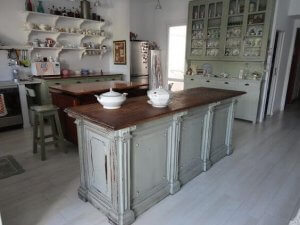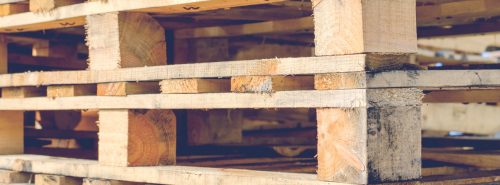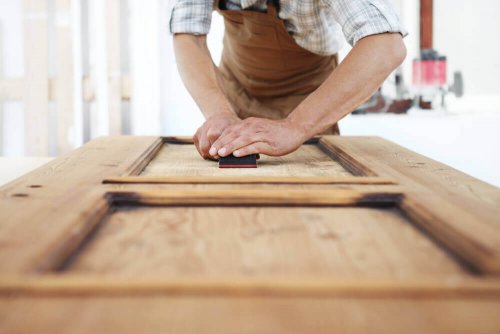Build Your Own Kitchen Island with Recycled Materials

Dreaming of a kitchen upgrade without breaking the bank? Look no further than a sustainable DIY project to build your own kitchen island using recycled materials. Not only will you add a unique touch to your culinary space, but you’ll also contribute to reducing waste and embracing an eco-friendly lifestyle. In this comprehensive guide, we’ll walk you through the step-by-step process of creating a one-of-a-kind kitchen island while making the most of recycled treasures.
1. Salvage Your Building Blocks
Building your own kitchen island starts with scouting for recycled materials. Consider repurposing old wooden pallets, reclaimed lumber, or even discarded furniture. Thrift stores, salvage yards, and online platforms are goldmines for finding affordable or free materials that can breathe new life into your kitchen.

2. Plan Your Design with Recycled Materials in Mind
Once you’ve gathered your recycled materials, it’s time to plan your design. The beauty of working with recycled elements lies in their uniqueness, so embrace the character and quirks of each piece. Sketch out your ideal kitchen island, considering the dimensions and features that align with both your kitchen space and the materials at hand.
3. Deconstruct and Prepare Your Materials
Prepare the recycled materials for construction by carefully deconstructing any existing structures. Remove nails, screws, or any elements that may compromise the integrity of your kitchen island. Sand the surfaces to create a smooth finish and assess whether any pieces need repairs or modifications to fit your design.
4. Build Your Frame
With your recycled materials ready, start building the frame of your kitchen island. Use the salvaged wood to construct a sturdy base, ensuring it aligns with your design specifications. Secure the joints with screws or nails, and don’t be afraid to mix and match materials to create a visually appealing and eclectic aesthetic.
5. Create a Distinctive Countertop

The countertop is a focal point of any kitchen island, and with recycled materials, you have the opportunity to make a statement. Consider using reclaimed wood, old doors, or even repurposed metal for a distinctive and sustainable surface. Ensure the countertop is level and securely attached to the frame. Another alternative is to look for a salvaged countertop for sale and make your island to fit its measurements!
6. Incorporate Recycled Storage Solutions
Enhance the functionality of your kitchen island by integrating recycled storage solutions. Salvage old drawers, crates, or wooden boxes to create unique storage compartments. These compartments can house pots, pans, or small kitchen appliances, adding both character and practicality to your DIY creation.
7. Add Wheels for Mobility
If you desire a mobile kitchen island, consider adding wheels salvaged from an old cart or repurposed furniture. This not only adds an industrial touch to your design but also allows you to move the island around the kitchen with ease. Opt for locking wheels to ensure stability when the island is in use.
8. Embrace imperfection
Recycled materials often come with a history, showcasing a beautiful patina that tells a story. Embrace these imperfections, as they contribute to the charm of your kitchen island. Consider using a clear sealant to protect the surfaces while allowing the natural character of the recycled materials to shine through.
9. Personalize with Recycled Accessories
Take your kitchen island to the next level by personalizing it with recycled accessories. Salvage old hooks, handles, or vintage hardware to add character to drawers or cabinets. Consider attaching recycled shelving for additional storage or repurposing old brackets to create hanging racks for pots and pans.
10. Build Your Own Kitchen Island with Recycled Materials: Final Touches
As you put the final touches on your eco-friendly kitchen island, step back and admire the transformation. The beauty of building your own kitchen island with recycled materials lies not only in its functionality but also in the sustainability and creativity embedded in the process.
Remember, the possibilities are endless when working with recycled materials. Whether it’s repurposing an old window as a unique backsplash or turning salvaged pipes into towel racks, let your imagination run wild. Building your own kitchen island with recycled materials is a testament to your commitment to sustainability and a celebration of the beauty found in repurposed treasures.
In conclusion, embark on the journey to build your own kitchen island with recycled materials and revel in the satisfaction of creating a sustainable and personalized centerpiece for your culinary haven. It’s not just a DIY project; it’s a commitment to a greener, more eco-conscious lifestyle that brings functionality and style to your kitchen in the most earth-friendly way possible.
Dreaming of a kitchen upgrade without breaking the bank? Look no further than a sustainable DIY project to build your own kitchen island using recycled materials. Not only will you add a unique touch to your culinary space, but you’ll also contribute to reducing waste and embracing an eco-friendly lifestyle. In this comprehensive guide, we’ll walk you through the step-by-step process of creating a one-of-a-kind kitchen island while making the most of recycled treasures.
1. Salvage Your Building Blocks
Building your own kitchen island starts with scouting for recycled materials. Consider repurposing old wooden pallets, reclaimed lumber, or even discarded furniture. Thrift stores, salvage yards, and online platforms are goldmines for finding affordable or free materials that can breathe new life into your kitchen.

2. Plan Your Design with Recycled Materials in Mind
Once you’ve gathered your recycled materials, it’s time to plan your design. The beauty of working with recycled elements lies in their uniqueness, so embrace the character and quirks of each piece. Sketch out your ideal kitchen island, considering the dimensions and features that align with both your kitchen space and the materials at hand.
3. Deconstruct and Prepare Your Materials
Prepare the recycled materials for construction by carefully deconstructing any existing structures. Remove nails, screws, or any elements that may compromise the integrity of your kitchen island. Sand the surfaces to create a smooth finish and assess whether any pieces need repairs or modifications to fit your design.
4. Build Your Frame
With your recycled materials ready, start building the frame of your kitchen island. Use the salvaged wood to construct a sturdy base, ensuring it aligns with your design specifications. Secure the joints with screws or nails, and don’t be afraid to mix and match materials to create a visually appealing and eclectic aesthetic.
5. Create a Distinctive Countertop

The countertop is a focal point of any kitchen island, and with recycled materials, you have the opportunity to make a statement. Consider using reclaimed wood, old doors, or even repurposed metal for a distinctive and sustainable surface. Ensure the countertop is level and securely attached to the frame. Another alternative is to look for a salvaged countertop for sale and make your island to fit its measurements!
6. Incorporate Recycled Storage Solutions
Enhance the functionality of your kitchen island by integrating recycled storage solutions. Salvage old drawers, crates, or wooden boxes to create unique storage compartments. These compartments can house pots, pans, or small kitchen appliances, adding both character and practicality to your DIY creation.
7. Add Wheels for Mobility
If you desire a mobile kitchen island, consider adding wheels salvaged from an old cart or repurposed furniture. This not only adds an industrial touch to your design but also allows you to move the island around the kitchen with ease. Opt for locking wheels to ensure stability when the island is in use.
8. Embrace imperfection
Recycled materials often come with a history, showcasing a beautiful patina that tells a story. Embrace these imperfections, as they contribute to the charm of your kitchen island. Consider using a clear sealant to protect the surfaces while allowing the natural character of the recycled materials to shine through.
9. Personalize with Recycled Accessories
Take your kitchen island to the next level by personalizing it with recycled accessories. Salvage old hooks, handles, or vintage hardware to add character to drawers or cabinets. Consider attaching recycled shelving for additional storage or repurposing old brackets to create hanging racks for pots and pans.
10. Build Your Own Kitchen Island with Recycled Materials: Final Touches
As you put the final touches on your eco-friendly kitchen island, step back and admire the transformation. The beauty of building your own kitchen island with recycled materials lies not only in its functionality but also in the sustainability and creativity embedded in the process.
Remember, the possibilities are endless when working with recycled materials. Whether it’s repurposing an old window as a unique backsplash or turning salvaged pipes into towel racks, let your imagination run wild. Building your own kitchen island with recycled materials is a testament to your commitment to sustainability and a celebration of the beauty found in repurposed treasures.
In conclusion, embark on the journey to build your own kitchen island with recycled materials and revel in the satisfaction of creating a sustainable and personalized centerpiece for your culinary haven. It’s not just a DIY project; it’s a commitment to a greener, more eco-conscious lifestyle that brings functionality and style to your kitchen in the most earth-friendly way possible.







